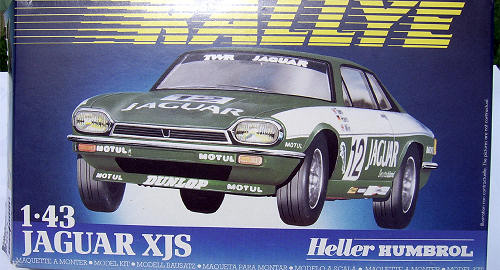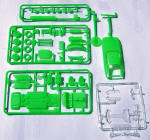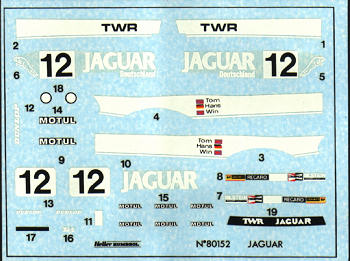
Heller 1/43 Jaguar XJS Rallye
| KIT: | Heller 1/43 Jaguar XJS Rallye |
| KIT #: | 80152 |
| PRICE: | $12.95 AUD |
| DECALS: | One option; Spa 1984 |
| REVIEWER: | Graham Mison |
| NOTES: | Currently OOP |

| HISTORY |
Jaguar released the first XJS in 1976 (XJ-S at the time) as the Mark I (1976-1980), followed by the Mark II (1980-91) and then the Mark III (1991-96). Marketed as a luxury GT and originally available with only one engine option, a 5.3 ltr V12, the car went through a number of cosmetic and engineering updates and the V12 was supplanted by a 4.3 ltr 6 and a 6.0 ltr version of the V12. The car was a success for the British manufacturer with total production exceeded 214,000. Mark I specifications and performance figures include: 5.3 ltr 60 degree V12 putting out 287 HP, nominal weight 1840 Kgs, 0-100 kph (60 mph) 6.7 seconds, top speed 158 mph.
Scotsman Tom Walkinshaw founded TWR (Tom Walkinshaw Racing) in 1976 and originally prepared BMWs and then Mazda's for Touring car racing in the UK and Europe. In 1982 he began a partnership with Jaguar owners' British Leyland and prepared and raced the factory XJS cars under the newly introduced FIA Group A Touring Car regulations. This new category was introduced to return touring car racing back to production based cars and was adopted, with local variations, through out Europe, Asia, Australia and New Zealand. The category lasted until the mid '90s when most countries replaced it with regulations more suited to their own local needs such as the German DTM series and V8 Supercars in Australia.
With TWR prepared vehicles Jaguar gained much success on the racetrack including a 1-2 finish in the 500 km Tourist Trophy at Silverstone in 1982. They had a very successful year in 1984 when Walkinshaw won the European Touring Car Championship (ETCC) and with co-drivers Win Percy and Hans Heyer took out the Spa 24 hour race in Belgium. The next year TWR retired the Jag's and switched to the Rover 3500 Vitesse, but that wasn't the end of the road for the dark green British Cats. Walkinshaw had become fascinated by the Bathurst 1,000 km race held in Australia each October. He put a plan together to take the 3 factory supplied cars to Mt. Panorama in 1985 and attempt to win The Great Race.
The cars were locally backed by Jaguar Racing Australia (JRA) and 2 local drivers in John Goss and Ron Dickson joined the team. TWR bought a level of professionalism to the local Touring Car scene that had not been seen before and were installed as favorites for the Race by the local motorsport press. Driver pairings were - Tom Walkinshaw and Win Percy in car #8 (the Spa 24 hour winner, which was taken out of Jaguar's Coventry museum for the event), Ron Dickson and Jeff Allam in car #9 and John Goss and Armin Hahne car #10.
Walkinshaw's plans were looking good when the 3 big Cats toped the timing sheets in Friday's first practice session and he scored Pole in Saturday's top 10 shoot-out, known as Hardie's Heroes (the race was sponsored by the James Hardie Company), with an amazing lap that saw the big Jag up on 2 wheels through the McPillamy Park section and hiking the inside wheels the best part of a metre in the air through The Dipper. This 1 lap brought more respect for the Scotsman from Aussie fans than any thing he'd done before.
At the start Walkinshaw jumped to an early lead and Allam joined him in 2nd. However the #9 car retired within 3 laps with engine dramas. Around mid race the #8 Jag suffered damage to the oil cooling system from a stone and pitted for a quick repair and then re-inherited the lead as those in front fell victim to other mechanical woes. Walkinshaw had built a handy lead when his car again had to have the oil line repaired on lap 129 and he and Percy fell back to 7th whilst it was.
The Goss / Hahne pairing also had their share of trouble when their light-weight racing seat broke early in the race and had to be repaired with cable ties. When the #8 car pitted on lap 129 (of 161) Goss inherited the lead from his team boss. Once back on the track Walkinshaw showed why he was regarded as one of the better European sedan drivers and worked his way back up to 3rd place by the end of the 161 laps. The Goss / Hahne victory was one of the most popular to that time with Goss a previous winner in 1974 in a Ford Falcon XA Hardtop. The 1985 Bathurst winning car still exits in Australia and occasionally makes appearances at Historic meetings. Recently the Spa winner was also returned to Australia and is also driven at Historic Meetings.
| THE KIT |
 Heller's kit of the Jaguar XJS was
first released in late 1979 (kit number 183) and as such represents the Mark
I version of the car. At the time it was considered a jump in molded detail
over what came before. It received a glowing review by David Jane in the 'New to
You' section of Scale Models, February 1980 (issue No.125). That original
release was for a standard left hand drive road car.
Heller's kit of the Jaguar XJS was
first released in late 1979 (kit number 183) and as such represents the Mark
I version of the car. At the time it was considered a jump in molded detail
over what came before. It received a glowing review by David Jane in the 'New to
You' section of Scale Models, February 1980 (issue No.125). That original
release was for a standard left hand drive road car.
This review kit is the later issued TWR 1984 Spa 24 Hours winner. This was issued in the Rallye series as kit 80152 under the Heller / Humbrol label, but I'm not sure of the year it landed on hobby shop shelves, late '80s or early '90s I'm guessing. Most of this series were kits of standard road going cars with new decals to represent a competition version. The box is the end opening type with a full colour drawing of the subject on the top and photos of a finished model on the bottom.
The kit consists of a total of 50 parts made up of 40 parts molded in lime green and 10 clear parts. Parts are well formed with no flash. Ejector pin marks are mostly confined to places that will be hidden from view once the parts are assembled, with the exception of the ones on the back of the bucket seats. Detail is quite good for this scale with the interior consisting of a floor pan with centre console and rear seats. To this there are to be attached a dashboard and separate steering wheel, gear stick, door trims and one front bucket seat. This is then to be mounted onto the chassis, which has integrally molded sump, gearbox, exhaust system, tail shaft and diff/axle. A 3-part engine is also included and this will help to stop the see through effect between the front wheels. No rollcage or racing seat is provided.
The body is almost complete as a single molding, with the boot (trunk for you North Americans), rear bumper and front bumper with integrally molded headlights and grille to be attached. The clear parts consist of a single piece front windscreen/rear window, side windows, taillights and headlights. These are well molded but will distort the view into the cabin.
I mention the wheels and tires separately as the wheels are the biggest letdown of this and most of the early Heller kits in this scale. Consisting of 2 halves, and molded in the same plastic as the rest of the kit, the tires have no tread what-so-ever and will need the join seem sanded down. Whilst slicks are appropriate for a Group A racer these are too narrow. In the original issue the wheels were chrome plated, in this racing version they are molded in lime green.
Instructions consist of an A-4 sized double-sided sheet showing a 2-stage construction sequence on one side with a 5-view decal placement guide on the other. The construction section, which appears to be the original kit issue with new paint numbers, includes painting instructions for individual pieces. Paint numbers are provided for both the Heller and Humbrol range, with a separate sheet having a comparison chart.
 Decals are for 1 vehicle, the 1984
Spa winner. These seem, after viewing images of the #12 car from that event, to
be mostly accurate and complete. The decals appear to be up to the usual Heller
/ Humbrol print quality, meaning the larger items are in good register but the
smaller items, such as the drivers national flags and some of the small sponsor
markings aren't. Previous experience tells me that they will be OK to use as
long as a nice gloss surface is provided to them, for this subject there is no
alternative that I know of anyway.
Decals are for 1 vehicle, the 1984
Spa winner. These seem, after viewing images of the #12 car from that event, to
be mostly accurate and complete. The decals appear to be up to the usual Heller
/ Humbrol print quality, meaning the larger items are in good register but the
smaller items, such as the drivers national flags and some of the small sponsor
markings aren't. Previous experience tells me that they will be OK to use as
long as a nice gloss surface is provided to them, for this subject there is no
alternative that I know of anyway.
To build an accurate model of the subject of this kit some modifications and scratch building will be necessary. A rollcage will need to be built, the steering wheel and dashboard modified to right hand drive, a racing seat added, wheels widened and the body lowered.
I purchased this kit to attempt a model of the 1985 Bathurst winner, a car I was able to view at the Muscle Car Masters at Eastern Creek Raceway in 2006. The above additions as well as hand made decals will be necessary for that, perhaps after modifying the kit I'll go with the Spa winner.
| REFERENCES |
Scale Models February 1980, issue 125 - Original release kit review.
Bathurst 1985, Published by Garry Sparke and Associates, ISBN 0 908081 58 8 - Images and info on the Walkinshaw Jaguars.
www.racingsportscars.com/etcc/Spa-1984-07-29-photo.html - Images of the Spa 24 Hour winner.
March 2008
If you would like your product reviewed fairly and quickly, please contact me or see other details in the Note to Contributors.